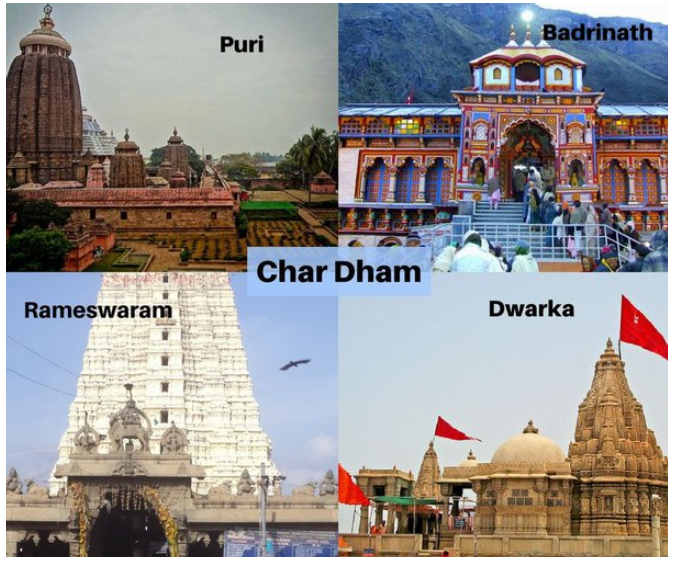Facts for UPSC Mains
Puri Jagannath Temple's Ratna Bhandar
- 15 Jul 2024
- 6 min read
Why in News?
Recently, the Odisha government unlocked the revered Ratna Bhandar of the 12th-century Jagannath temple in Puri after 46 years.
What is Jagannath Temple’s Ratna Bhandar?
- About:
- The Ratna Bhandar is a valuable collection of treasures, located on the northern side of the Jagamohana (assembly hall of temple).
- It contains the priceless jewelry of the sibling deities Lord Jagannath, Lord Balabhadra, and Goddess Subhadra which have been offered by former kings over many centuries and by devotees from around the globe.
- The Records of Rights created in accordance with the Puri Sri Jagannath Temple Act, 1952, includes an inventory of the precious jewelry and assorted adornments belonging to Lord Jagannath.
- It contains two chambers namely the outer (Bahara Bhandar) and inner chamber (Bhitar Bhandar), which has remained closed for the past 46 years.
- As per the inventory last made in 1978, the Ratna Bhandar has a total 128.38 kg of gold and 221.53 kg of silver.
- The Archaeological Survey of India (ASI), is the custodian of the temple and had performed a structural inspection of the Ratna Bhandar in 2008 but could not enter the inner chamber.
What are the Key Facts About Jagannath Temple?
- Puri’s Jagannath temple is among the most revered Hindu shrines in the state (and India), is dedicated to the worship of Lord Jagannath, believed to be an incarnation of Vishnu, along with his older brother Balabhadra and sister Subhadra.
- It is known as the “White Pagoda” and is one of the chardhams, four of the most sacred pilgrimage sites for Hindus.
- It is also part of the Golden Triangle of Odisha which includes three major tourist destinations in the state that form a triangle and are well-connected.
- It was constructed by a famous king of Ganga Dynasty Ananta Varman Chodaganga Deva dating back to the 12th century.
- It is an outstanding example of Kalinga architecture, featuring distinctive curvilinear towers, intricate carvings, and ornate sculptures.
- The four gates of the Jagannath temple are located on the mid-points of its boundary wall, and face the four cardinal directions. They are named after different animals.
| Gate | Direction | Belief |
| Singhadwara (Lion's Gate) | East | Attain moksha (liberation from the cycle of birth-rebirth) |
| Hastidwara (Elephant Gate) | North | Brings wealth |
| Aswadwara (Horse Gate) | South | Helps one shed kama (lust) |
| Vyaghradwara (Tiger Gate) | West | Reminds one of one's dharma (cosmic law underlying right behaviour and social order) |
- It is also called as ‘Yamanika Tirtha’ where, according to the Hindu beliefs, the power of ‘Yama’, the god of death, has been nullified in Puri due to the presence of Lord Jagannath.
- Associated Major Festivals: Snana Yatra, Netrotsava, Rath Yatra, Sayan Ekadasi.
Odisha School (Kalinga Architecture)
- It is a sub-school of the Nagara school, developed in various parts of the Kalinga empire. Some of its features were:
- The exterior walls were lavishly decorated with intricate carvings, but the interior walls were plain.
- There was no use of pillars in the porch. Iron girders were used instead to support the roof.
- The shikhara in the Odisha school was known as rekha deul. They were almost vertical roofs which suddenly curved inwards sharply.
Read more: Temple Architecture
UPSC Civil Services Examination, Previous Year Question (PYQ)
Prelims:
Q. With reference to Chausath Yogini Temple situated near Morena, consider the following statements: (2021)
- It is a circular temple built during the reign of Kachchhapaghata Dynasty.
- It is the only circular temple built in India.
- It was meant to promote the Vaishnava cult in the region.
- Its design has given rise to a popular belief that it was the inspiration behind the Indian Parliament building.
Which of the statements given above are correct?
(a) 1 and 2
(b) 2 and 3 only
(c) 1 and 4
(d) 2, 3 and 4
Ans: (c)
Q. Building ‘Kalyaana Mandapas’ was a notable feature in the temple construction in the kingdom of (2019)
(a) Chalukya
(b) Chandela
(c) Rashtrakuta
(d) Vijayanagara
Ans: (d)
Mains:
Q. The rock-cut architecture represents one of the most important sources of our knowledge of early Indian art and history. Discuss. (2020)






-min.jpg)